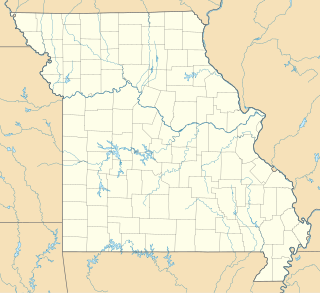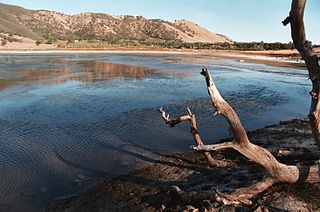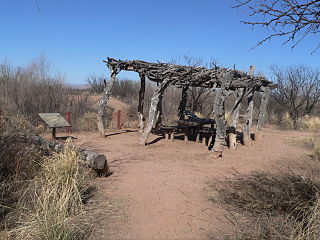 W
WThe Big Eddy Site (23CE426) is an archaeological site located in Cedar County, Missouri, which was first excavated in 1997 and is now threatened due to erosion by the Sac River.
 W
WBlackwater Draw is an intermittent stream channel about 140 km (87 mi) long, with headwaters in Roosevelt County, New Mexico, about 18 km (11 mi) southwest of Clovis, New Mexico, and flows southeastward across the Llano Estacado toward the city of Lubbock, Texas, where it joins Yellow House Draw to form Yellow House Canyon at the head of the North Fork Double Mountain Fork Brazos River. It stretches across eastern Roosevelt County, New Mexico, and Bailey, Lamb, Hale, and Lubbock Counties of West Texas and drains an area of 1,560 sq mi (4,040 km2).
 W
WBlackwater Draw is an intermittent stream channel about 140 km (87 mi) long, with headwaters in Roosevelt County, New Mexico, about 18 km (11 mi) southwest of Clovis, New Mexico, and flows southeastward across the Llano Estacado toward the city of Lubbock, Texas, where it joins Yellow House Draw to form Yellow House Canyon at the head of the North Fork Double Mountain Fork Brazos River. It stretches across eastern Roosevelt County, New Mexico, and Bailey, Lamb, Hale, and Lubbock Counties of West Texas and drains an area of 1,560 sq mi (4,040 km2).
 W
WThe Borax Lake Site, also known as the Borax Lake—Hodges Archaeological Site and designated by the Smithsonian trinomial CA-LAK-36, is a prehistoric archaeological site near Clearlake, California. The site, a deeply stratified former lakeshore, contains evidence of the earliest known period of human habitation in what is now California, dating back 12,000 years. A portion of the site, designated a National Historic Landmark in 2006, is owned and preserved by the Archaeological Conservancy.
 W
WEl Fin del Mundo is an ancient Pleistocene site near Pitiquito in northwestern Sonora, Mexico. It features Clovis culture period occupation dating around 13,390 calibrated years BP. It was discovered during a 2007 survey.
 W
WThe archaeology of Iowa is the study of the buried remains of human culture within the U.S. state of Iowa from the earliest prehistoric through the late historic periods. When the American Indians first arrived in what is now Iowa more than 13,000 years ago, they were hunters and gatherers living in a Pleistocene glacial landscape. By the time European explorers visited Iowa, American Indians were largely settled farmers with complex economic, social, and political systems. This transformation happened gradually. During the Archaic period American Indians adapted to local environments and ecosystems, slowly becoming more sedentary as populations increased. More than 3,000 years ago, during the Late Archaic period, American Indians in Iowa began utilizing domesticated plants. The subsequent Woodland period saw an increase on the reliance on agriculture and social complexity, with increased use of mounds, ceramics, and specialized subsistence. During the Late Prehistoric period increased use of maize and social changes led to social flourishing and nucleated settlements. The arrival of European trade goods and diseases in the Protohistoric period led to dramatic population shifts and economic and social upheaval, with the arrival of new tribes and early European explorers and traders. During the Historical period European traders and American Indians in Iowa gave way to American settlers and Iowa was transformed into an agricultural state.
 W
WThe Lehner Mammoth-Kill Site is a location in southern Arizona that is significant for its association with evidence that mammoths were killed here by Paleo-Indians 9000 years BCE.
The Levi Rock Shelter, named for former property owner Malcolm Levi, is an archeological site west of Austin, Texas where Paleo-Indian Native American artifacts dating back 10,000 years or more have been discovered.
 W
WMastodon State Historic Site is a publicly owned, 431-acre (174 ha) archaeological and paleontological site with recreational features in Imperial, Missouri, maintained by the Missouri Department of Natural Resources, preserving the Kimmswick Bone Bed. Bones of mastodons and other now-extinct animals were first found here in the early 19th century. The area gained fame as one of the most extensive Pleistocene ice age deposits in the country and attracted scientific interest worldwide.
 W
WMurray Springs is located in southern Arizona near the San Pedro River and once served as a Clovis hunting camp approximately 9000 years BCE. The site is unique for the massive quantity of large megafauna processing and extensive tool making. Archaeologists identified five buried animal kills and processing locations and a Clovis camp location. The site is located in the San Pedro Riparian National Conservation Area, administered by the Bureau of Land Management.
 W
WThe Naco Mammoth Kill Site is an archaeological site in southeast Arizona, near Naco, Arizona. The site was reported to the Arizona State Museum in September 1951 by Marc Navarrete, a local resident, after his father found two Clovis points in Greenbush Draw, while digging out the fossil bones of a mammoth. Emil Haury excavated the Naco mammoth site in April 1952. In only five days, Haury recovered the remains of a Columbian Mammoth that had been killed by the use of at least 8 Clovis points about 10,000 years ago. The Naco site was the first Clovis mammoth kill association to be identified.
 W
WNenana Valley is an archaeological site in the Yukon-Koyukuk Census Area of Alaska.
 W
WThe Williamson Site is an early prehistoric archaeological site located near Dinwiddie, Dinwiddie County, Virginia. It is one of the largest Early Man sites in North America and dated to sometime between 15,000 and 11,500 years ago. The site was first identified in 1947, and consists of more than 75 acres of cultivated land. The site consists of over 100 areas where Clovis projectile points have been found.